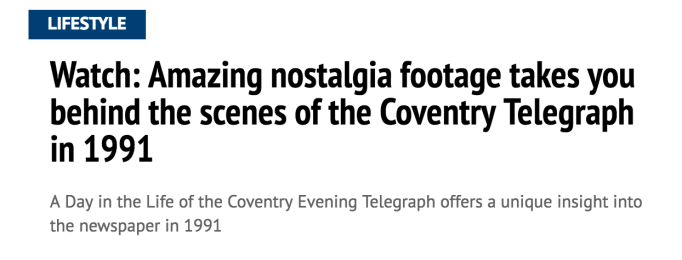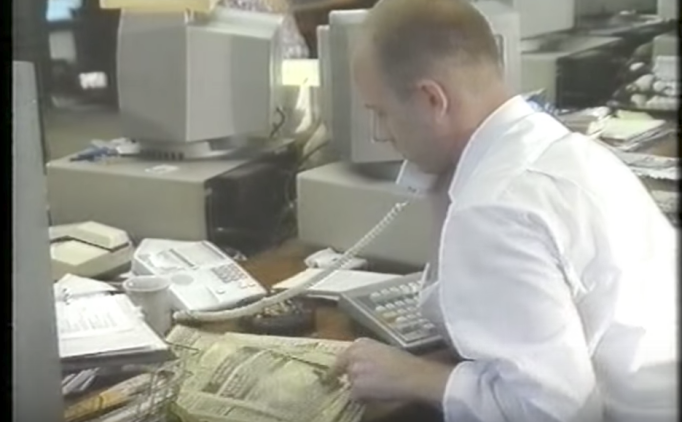There’s a feast of enticing TV on tonight: Game of Thrones, the final of Love Island, Harry and Wills talking about their mum on ITV1 – and the final episode of the compelling Ripper Street.
But I’ve already been gripped by a captivating piece of programme-making.
I can’t imagine that the audience for A Day in the Life of the Coventry Evening Telegraph troubled the ratings scorers when it was shown on that city’s cable TV channel back in 1991.
I never worked there. But the 33-minute documentary took me straight back to the newsrooms which were my second homes in the 80s and 90s: in Exeter, Torquay, Swindon and Bath.
They were the scenes of some great times, and had an atmosphere – smells, sounds, sayings and systems – all of their own.

They also had sales figures and editorial staff numbers that would now be the stuff of utter fantasy.
But would I like to turn the clock back 26 years? I’m not so sure – and here’s why.
1. All those men in white shirts

Blimey, we were corporate and male, then, weren’t we? I didn’t see a single woman in conference. With the exception of crime reporter Sue Lary, and a shot of a woman in paste-up, it was pretty much wall-to-wall blokes. And men in white-shirt-and-boring-tie combo, in particular. The BBC’s gender gap problems are a woman vicar’s tea party compared with this lot. Thankfully, we’ve moved on in the last two and half decades. And leaving aside the fact that there are now women in editors’ chairs in every part of the country, we’ve also relaxed our dress codes away from that Man at C&A look.
2. All that faff
I don’t know how long that conference would have gone on for, but I suspect it was more than half an hour, tying up half a dozen of those MANagers. And I suspect there was another set-piece meeting later in the day. If they were anything like the ones I took part in, they would have gone into tedious detail and featured intense debate about whether a picture should go on page 17 or 7. And then there’s those production processes. Of course it was desperately sad when long-serving employees lost their jobs, but an awful lot of those jobs involved just carrying pieces of paper or metal around. So one can mourn the loss of a whole vocabulary of titles, production areas and skills, while being grateful for technology that saves both time and money.
3. All those offices
When I started on my first newspaper in Exeter in 1985, the editor was dozens of yards away down a corridor. In his office, mostly with the door closed. Lord knows what he did all day. Little more than 20 years ago, the editor, deputy editor and associate editor of The Bath Chronicle all had their own offices. Managing directors were people you might see once or twice a year, and who wouldn’t know your name. Now, I only know one editor who spends more time in their office than out in the newsroom – and many editors don’t even have an office. They lead from the front and have to eyeball their staff pretty much all the time. Which is as it should be.
4. All those Yellow Pages

And fax machines. And spikes. And post to open. All that paraphernalia of the pre-internet age, when the only way to track people down was by using a phone or a door knocker. When you could miss a splash if the post was held up, and when investigative research relied on public libraries and the occasional bundle of papers in a hedge. And, of course, when if a story broke at 3pm, you’d have to wait until the next day before you could tell anyone.
5. All those laurels to rest on
There’s a comment from then Telegraph editor Neil Benson that really sticks in my mind.

Asked whether bad news sells papers, he acknowledges that it might boost his sales a bit.
But he says the paper sells 90,000 copies a day ‘more or less irrespective of what’s in it.’
Oh happy day. Oh happy day when, in a city of 300,000 people, you achieve something close to total penetration, no matter what you did. When you have to beat a radio station or two, and your two regional TV newsrooms, but never have to worry about people-powered news websites, or Twitter, or football clubs cutting you out of the equation altogether.
I’ve argued strongly before that the reporters of today have to work far harder than I ever did, 26, 16 or six years ago.
And I think the discipline of having to cope with a multimedia, transient, hypercritical audience means our journalism is better. I know much of the writing certainly is, having seen some of the tortuous rubbish that passed muster in my youth.
The Good Old Days?
So, while it’s tempting to hark back to those so-called good old days, I’m resisting the urge.
On the surface of it, life in those packed newsrooms producing papers snapped up by entire communities feels like a golden age.
But the joy of journalism can be as real now as it was 26 years ago, with new ways of telling stories, and new platforms to reach audiences undreamed of in 1991.
And there’s certainly never been a greater need for what we do.

Very interesting piece, Paul. And I’ve also read the Press Gazette article. I totally agree that there are so many fabulous ways to tell stories now. But modern newsrooms are stripped to the bone, countless good stories are missed, subbing often seems like a lost art and what passes for news in some publications is often laughable. And as for management not leading from the front – I suspect nothing changes there!
There is an elephant in the newsroom here. Throughout this piece you kind of overlook the fact that in those days newspapers had READERS.